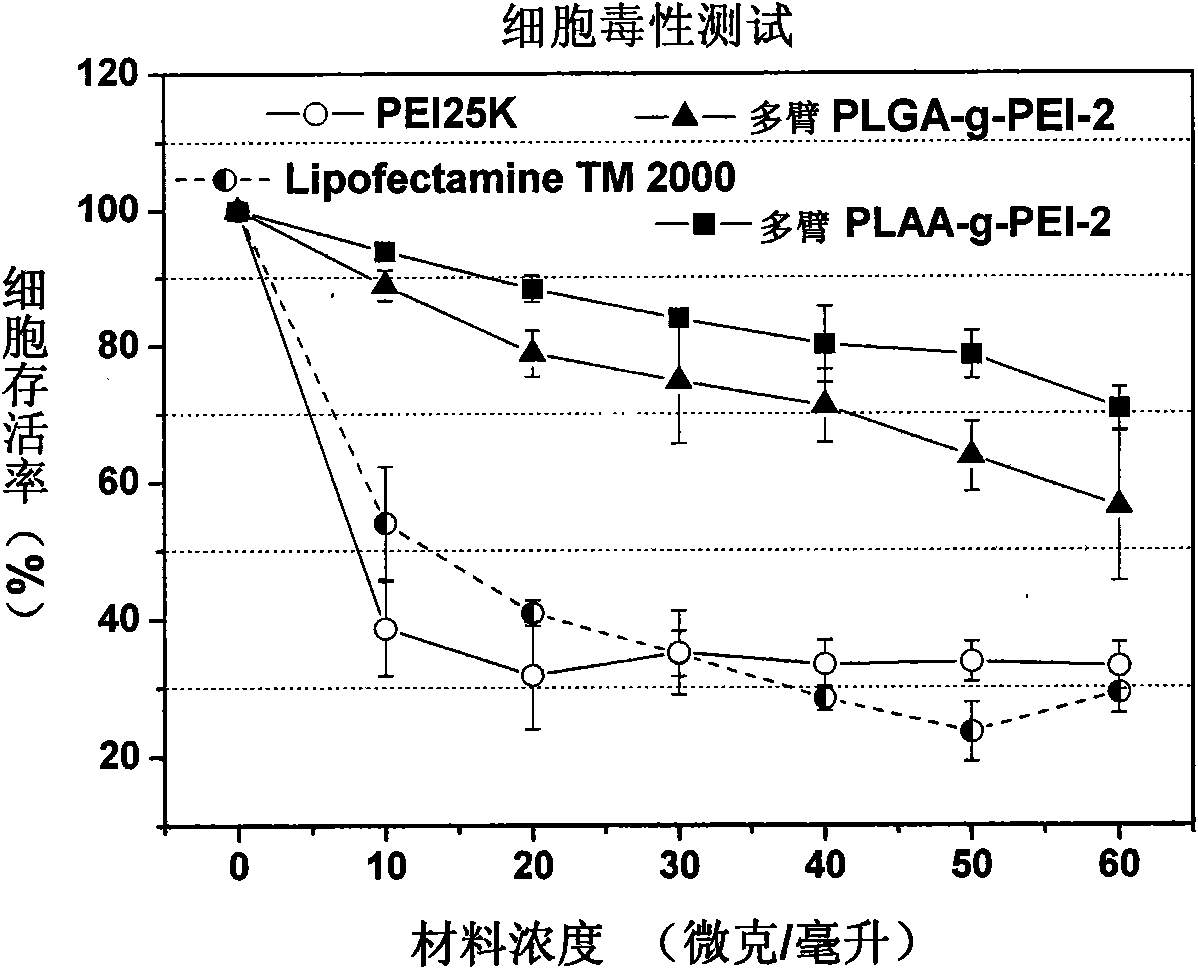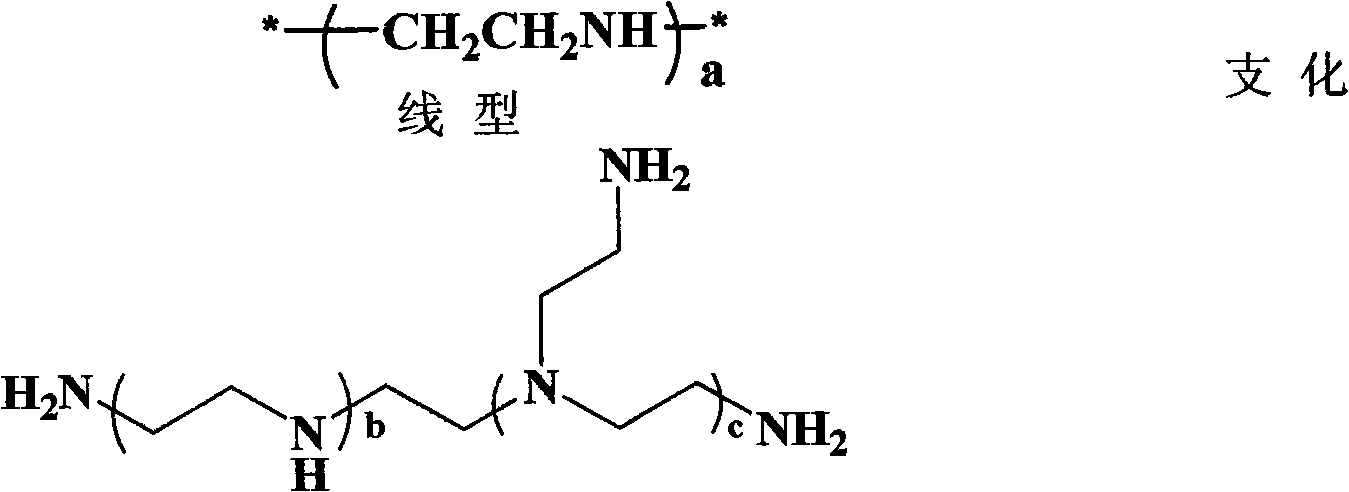Multi-arm polyamino acid (ester) grafted polyethyleneimine copolymer, preparation method and application in gene delivery
A polyethyleneimine copolymer and polyethyleneimine technology are applied to multi-arm polyamino acid (ester) grafted polyethyleneimine copolymer and preparation method and the application field in gene transfer, which can solve the PEI charge density Insufficient concentration and other problems, to achieve the effect of good biocompatibility, low cytotoxicity and high transfection efficiency
- Summary
- Abstract
- Description
- Claims
- Application Information
AI Technical Summary
Problems solved by technology
Method used
Image
Examples
Embodiment 1
[0035] Example 1: Synthesis of multi-armed poly-L-glutamate γ-benzyl esters using different polyamine initiators.
[0036] Under anhydrous and oxygen-free conditions, weigh 5 grams of γ-benzyl-L-glutamic acid-N-carboxylic acid anhydride and add them to different dry reaction ampoules, fill with nitrogen protection, and then add 500ml of anhydrous Chloroform, stir to make it dissolve; With the branched polyethyleneimine (branched PEI, MW=600; 1800) that molecular weight is 600 or 1800 as polyamine initiator, dissolve and prepare in anhydrous chloroform with the concentration of 0.01mmol / ml According to the volume of the initiator in Table 1, absorb and add to the corresponding reaction ampoule respectively, and stir the reaction at 30°C for 72 hours under temperature control; after the reaction is completed, settle in 5000ml of ether respectively, filter and dry cake, the white solid product multi-arm poly-L-glutamic acid γ-benzyl ester (multi-arm PBLG) was obtained, and the mo...
Embodiment 2
[0039] Example 2: Synthesis of multi-armed poly-L-aspartic acid β-benzyl esters using different polyamine initiators.
[0040] Under anhydrous and oxygen-free conditions, weigh 4.7 grams of β-benzyl-L-aspartic acid-N-carboxylic acid anhydride and add them to different dry reaction ampoules, fill with nitrogen protection, and then add 300ml of anhydrous Water N'N'-dimethylformamide, stirred to dissolve; branched polyethyleneimine (branched PEI, MW=600; 1800) with a molecular weight of 600 or 1800 was used as a polyamine initiator, and 0.01 mmol / ml concentration dissolved in anhydrous chloroform, according to the volume of the initiator in Table 2, were absorbed and added to the corresponding reaction ampoule, temperature control at 30 ° C stirring reaction for 72 hours; after the completion of the reaction, respectively Settled in 3000ml of ether, filtered and dried the filter cake to obtain the product multi-arm poly-L-aspartic acid β-benzyl ester (multi-arm PBLA). The produc...
Embodiment 3
[0043] Embodiment 3: Synthesis of multi-arm poly-L-glutamic acid (ester) graft polyethyleneimine copolymer by catalytic aminolysis method
[0044] Weigh respectively 2.2 grams (containing 10mmol benzyl ester group) of multi-arm poly-L-glutamic acid γ-benzyl ester (multi-arm PBLG 1 or multi-arm PBLG 3) in different reaction ampoules, and then according to Table 3 Add the corresponding polyethyleneimine (PEI) and 2-hydroxypyridine (HP) respectively in the molar amount of feeding, and the types of feeding PEI are respectively: linear polyethyleneimine with a molecular weight of 423 (linear PEI, MW=423), The branched polyethyleneimine (branched PEI, MW=600) that molecular weight is 600 or the branched polyethyleneimine (branched PEI, MW=1800) that molecular weight is 1800, see table 3; Dimethyl sulfoxide was stirred to dissolve it, the temperature was controlled at 38°C, and the reaction was stirred for 48 hours; The liquid after dialysis is lyophilized to obtain multi-arm poly-L...
PUM
 Login to View More
Login to View More Abstract
Description
Claims
Application Information
 Login to View More
Login to View More - R&D
- Intellectual Property
- Life Sciences
- Materials
- Tech Scout
- Unparalleled Data Quality
- Higher Quality Content
- 60% Fewer Hallucinations
Browse by: Latest US Patents, China's latest patents, Technical Efficacy Thesaurus, Application Domain, Technology Topic, Popular Technical Reports.
© 2025 PatSnap. All rights reserved.Legal|Privacy policy|Modern Slavery Act Transparency Statement|Sitemap|About US| Contact US: help@patsnap.com



